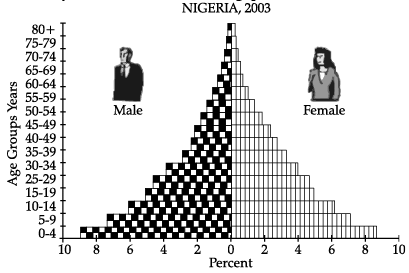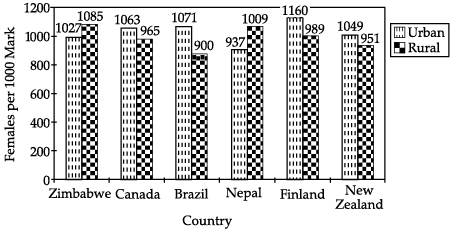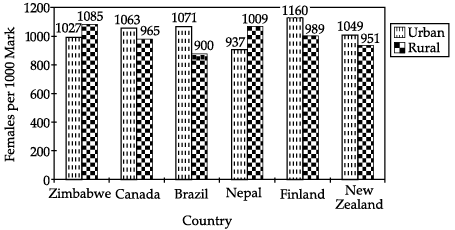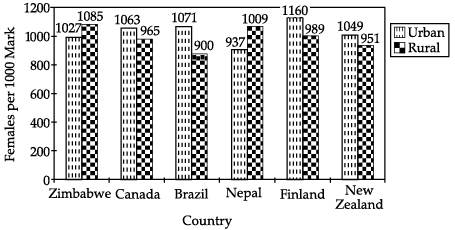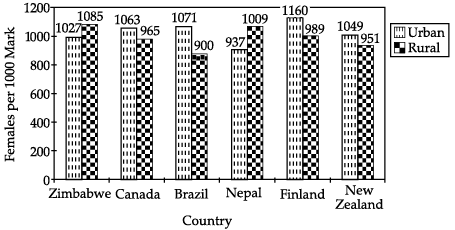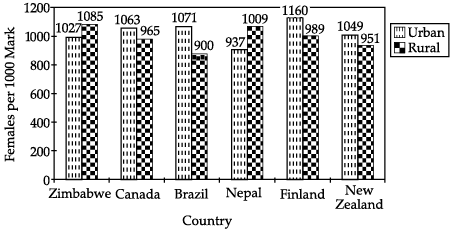All Exams >
Humanities/Arts >
Geography CUET UG Mock Test Series 2026 >
All Questions
All questions of Population Composition for Humanities/Arts Exam
In what country is the sex ratio calculated using the formula: female population 1000 male population or the number of females per thousand males.- a)Qatar
- b)China
- c)Latvia
- d)India
Correct answer is option 'D'. Can you explain this answer?
In what country is the sex ratio calculated using the formula: female population 1000 male population or the number of females per thousand males.
a)
Qatar
b)
China
c)
Latvia
d)
India

|
Niraj answered |
It means how many women are there in 1000 of men. in current analysis india's sex ratio is about 1020 women per 1000 men.
What country has a triangular-shaped pyramid with a broad base?
- a)All of these
- b)Nigeria
- c)Mexico
- d)Bangladesh
Correct answer is option 'A'. Can you explain this answer?
What country has a triangular-shaped pyramid with a broad base?
a)
All of these
b)
Nigeria
c)
Mexico
d)
Bangladesh
|
|
Mansi Banerjee answered |
The correct answer is option 'A', Bangladesh.
Explanation:
Bangladesh is a country located in South Asia. It is known for its rich cultural heritage and historical landmarks. One of the most famous landmarks in Bangladesh is the triangular-shaped pyramid with a broad base, known as the Boro Shona Mosque.
Boro Shona Mosque:
The Boro Shona Mosque is located in the village of Chapai Nawabganj in Bangladesh. It was built in the 15th century during the reign of Sultan Ruknuddin Barbak Shah, who was a ruler of the Bengal Sultanate. The mosque is also known as the Great Golden Mosque because of its golden exterior.
Architecture:
The Boro Shona Mosque is a unique example of Islamic architecture in Bangladesh. It is a triangular-shaped pyramid with a broad base, which is a rare feature in Islamic architecture. The mosque is made of brick and terracotta and is decorated with intricate carvings and designs.
The mosque has three domes on top of the triangular structure, which are also decorated with intricate designs. The interior of the mosque is also decorated with beautiful carvings and designs.
Conclusion:
In conclusion, Bangladesh is the country that has a triangular-shaped pyramid with a broad base, known as the Boro Shona Mosque. The mosque is a unique example of Islamic architecture and is a popular landmark in Bangladesh.
Explanation:
Bangladesh is a country located in South Asia. It is known for its rich cultural heritage and historical landmarks. One of the most famous landmarks in Bangladesh is the triangular-shaped pyramid with a broad base, known as the Boro Shona Mosque.
Boro Shona Mosque:
The Boro Shona Mosque is located in the village of Chapai Nawabganj in Bangladesh. It was built in the 15th century during the reign of Sultan Ruknuddin Barbak Shah, who was a ruler of the Bengal Sultanate. The mosque is also known as the Great Golden Mosque because of its golden exterior.
Architecture:
The Boro Shona Mosque is a unique example of Islamic architecture in Bangladesh. It is a triangular-shaped pyramid with a broad base, which is a rare feature in Islamic architecture. The mosque is made of brick and terracotta and is decorated with intricate carvings and designs.
The mosque has three domes on top of the triangular structure, which are also decorated with intricate designs. The interior of the mosque is also decorated with beautiful carvings and designs.
Conclusion:
In conclusion, Bangladesh is the country that has a triangular-shaped pyramid with a broad base, known as the Boro Shona Mosque. The mosque is a unique example of Islamic architecture and is a popular landmark in Bangladesh.
Sex Ratio in India in 2001 was :- a)921
- b)931
- c)933
- d)923
Correct answer is option 'C'. Can you explain this answer?
Sex Ratio in India in 2001 was :
a)
921
b)
931
c)
933
d)
923
|
|
Rishabh Sengupta answered |
Sex Ratio in India is continuously decreasing.
Progressive populations represented by:- a)A wide base and tapering pyramid .
- b)A narrow base and a tapering top .
- c)A regular pyramid
- d)An irregular pyramid
Correct answer is option 'A'. Can you explain this answer?
Progressive populations represented by:
a)
A wide base and tapering pyramid .
b)
A narrow base and a tapering top .
c)
A regular pyramid
d)
An irregular pyramid
|
|
Niti Basak answered |
The correct option is A.
A wide base means there are lots of young people, and suggests a high birth rate. A narrow base means a smaller proportion of young people, suggesting a low birth rate. A wide middle, tall pyramid means an ageing population, suggesting that there is a long life expectancy
A wide base means there are lots of young people, and suggests a high birth rate. A narrow base means a smaller proportion of young people, suggesting a low birth rate. A wide middle, tall pyramid means an ageing population, suggesting that there is a long life expectancy
Study the given graph carefully and answer the following questions: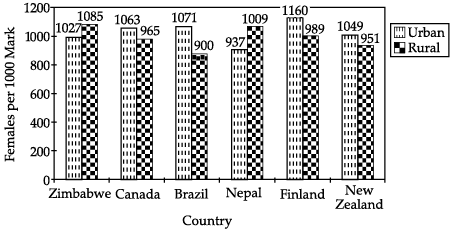 Which of these countries has a lower urban sex composition as compared to the rural one?
Which of these countries has a lower urban sex composition as compared to the rural one?- a)Zimbabwe
- b)Nepal
- c)Both a and b
- d)None of these
Correct answer is option 'C'. Can you explain this answer?
Study the given graph carefully and answer the following questions:

Which of these countries has a lower urban sex composition as compared to the rural one?
a)
Zimbabwe
b)
Nepal
c)
Both a and b
d)
None of these
|
|
Rajesh Gupta answered |
Both Zimbabve and Nepal have a lower urban sex composition as compared to the rural one.
About 78% of India's population is living in- a)rural areas.
- b)urban areas.
- c)plain areas.
- d)the metro cities.
Correct answer is option 'A'. Can you explain this answer?
About 78% of India's population is living in
a)
rural areas.
b)
urban areas.
c)
plain areas.
d)
the metro cities.
|
|
Sounak Nambiar answered |
India is an agrarian country and about one third of the population live in rural areas engaged in primary activities.
Read the case study given below and answer the questions that follow:The working population (i.e., women and men of the age group – 15 to 59) take part in various occupations ranging from agriculture, forestry, fishing, manufacturing construction, commercial transport, services, communication and other unclassified services. Agriculture, forestry, fishing and mining are classified as primary activities manufacturing as secondary, transport, communication and other services as tertiary and the jobs related to research and developing ideas as quaternary activities. The proportion of working population engaged in these four sectors is a good indicator of the levels of economic development of a nation. This is because only a developed economy with industries and infrastructure can accommodate more workers in the secondary, tertiary and quaternary sector. If the economy is still in the primitive stages, then the proportion of people engaged in primary activities world be high as it involves extraction of natural resources.Specialised tertiary activities are also known as :- a)Professional activities
- b)Quaternary activities
- c)Tertiary activities
- d)None of the Above
Correct answer is option 'B'. Can you explain this answer?
Read the case study given below and answer the questions that follow:
The working population (i.e., women and men of the age group – 15 to 59) take part in various occupations ranging from agriculture, forestry, fishing, manufacturing construction, commercial transport, services, communication and other unclassified services. Agriculture, forestry, fishing and mining are classified as primary activities manufacturing as secondary, transport, communication and other services as tertiary and the jobs related to research and developing ideas as quaternary activities. The proportion of working population engaged in these four sectors is a good indicator of the levels of economic development of a nation. This is because only a developed economy with industries and infrastructure can accommodate more workers in the secondary, tertiary and quaternary sector. If the economy is still in the primitive stages, then the proportion of people engaged in primary activities world be high as it involves extraction of natural resources.
Specialised tertiary activities are also known as :
a)
Professional activities
b)
Quaternary activities
c)
Tertiary activities
d)
None of the Above
|
|
Hansa Sharma answered |
Specialised tertiary activities are also known as Quaternary activities.
Most urbanised continent of the world is- a)Europe.
- b)North America.
- c)Australia.
- d)Latin America.
Correct answer is option 'B'. Can you explain this answer?
Most urbanised continent of the world is
a)
Europe.
b)
North America.
c)
Australia.
d)
Latin America.
|
|
Parth Chatterjee answered |
North America is most urbanised. Most people now live in urban areas. Three quarters of the population of the United States is urban, and one quarter is rural.
What is an indicator of socio-economic development as it reveals the standard of living, the social status of females, the availability of educational facilities, and government policies?- a)Literacy
- b)Transport
- c)Poverty
- d)Numeracy
Correct answer is option 'A'. Can you explain this answer?
What is an indicator of socio-economic development as it reveals the standard of living, the social status of females, the availability of educational facilities, and government policies?
a)
Literacy
b)
Transport
c)
Poverty
d)
Numeracy
|
|
Arjun Singhania answered |
An indicator of socio-economic development that reveals the standard of living, the social status of females, the availability of educational facilities, and government policies is (a) literacy.
Literacy is the ability to read and write, and it is an important indicator of socio-economic development because it reflects a number of important factors that influence the well-being and prosperity of a society. These factors include the standard of living, the social status of females, the availability of educational facilities, and government policies.
Higher levels of literacy are generally associated with higher levels of socio-economic development, as they tend to be correlated with higher levels of education, income, and employment. Literacy is also an important predictor of other positive outcomes, such as improved health, increased civic participation, and greater social mobility.
In summary, literacy is an important indicator of socio-economic development because it reflects the standard of living, the social status of females, the availability of educational facilities, and government policies.
Demographic structure explains only those characteristics of population, which are- a)quantitative.
- b)qualitative.
- c)most distinct.
- d)rare.
Correct answer is option 'A'. Can you explain this answer?
Demographic structure explains only those characteristics of population, which are
a)
quantitative.
b)
qualitative.
c)
most distinct.
d)
rare.
|
|
Nitin Chakraborty answered |
Demographic structure explains only those characteristics of population, which are quantitative like sex ratio, literacy rate, age structure, etc.
Population composition is also known as- a)population structure.
- b)demographic structure.
- c)sex structure.
- d)age structure.
Correct answer is option 'B'. Can you explain this answer?
Population composition is also known as
a)
population structure.
b)
demographic structure.
c)
sex structure.
d)
age structure.
|
|
Arnav Chakraborty answered |
Population composition includes males, females, rural-urban working, and non working population.
Literacy rate denotes the percentage of population above the age of- a)5 years.
- b)7 years.
- c)11 years.
- d)16 years.
Correct answer is option 'B'. Can you explain this answer?
Literacy rate denotes the percentage of population above the age of
a)
5 years.
b)
7 years.
c)
11 years.
d)
16 years.
|
|
Harsh Roy answered |
The correct answer is option 'b) 7 years'.
**Explanation:**
Literacy rate is a measure of the percentage of people in a population who can read and write. It is commonly used as an indicator of a country's education level and overall development. The literacy rate is usually calculated by dividing the number of literate individuals by the total population and multiplying by 100 to get the percentage.
In this question, the literacy rate is denoted for a specific age group. The options given represent different age groups, and we need to determine which one is correct for calculating the literacy rate.
To understand why option 'b) 7 years' is the correct answer, let's analyze the other options:
a) 5 years: Calculating the literacy rate for the population above 5 years of age would include young children who are typically not yet enrolled in primary education. This age group may not be suitable for measuring literacy as many children are still in the early stages of learning to read and write.
c) 11 years: This age group includes children who are usually enrolled in primary education. However, some children may still be in the early stages of literacy development, while others may have already acquired basic reading and writing skills. This age group is a possible option for calculating literacy rate, but it may not provide a comprehensive picture of a country's literacy level.
d) 16 years: This age group includes adolescents who have completed or are about to complete their secondary education. By this age, individuals are expected to have acquired basic literacy skills. However, using this age group may not capture the literacy levels of the entire population, as it excludes individuals who have not had the opportunity to receive formal education or who have dropped out before completing secondary education.
Therefore, option 'b) 7 years' is the most suitable choice for calculating the literacy rate as it includes children who have typically started primary education and have had some exposure to reading and writing instruction. This age group provides a more representative measure of the overall literacy level within a population.
**Explanation:**
Literacy rate is a measure of the percentage of people in a population who can read and write. It is commonly used as an indicator of a country's education level and overall development. The literacy rate is usually calculated by dividing the number of literate individuals by the total population and multiplying by 100 to get the percentage.
In this question, the literacy rate is denoted for a specific age group. The options given represent different age groups, and we need to determine which one is correct for calculating the literacy rate.
To understand why option 'b) 7 years' is the correct answer, let's analyze the other options:
a) 5 years: Calculating the literacy rate for the population above 5 years of age would include young children who are typically not yet enrolled in primary education. This age group may not be suitable for measuring literacy as many children are still in the early stages of learning to read and write.
c) 11 years: This age group includes children who are usually enrolled in primary education. However, some children may still be in the early stages of literacy development, while others may have already acquired basic reading and writing skills. This age group is a possible option for calculating literacy rate, but it may not provide a comprehensive picture of a country's literacy level.
d) 16 years: This age group includes adolescents who have completed or are about to complete their secondary education. By this age, individuals are expected to have acquired basic literacy skills. However, using this age group may not capture the literacy levels of the entire population, as it excludes individuals who have not had the opportunity to receive formal education or who have dropped out before completing secondary education.
Therefore, option 'b) 7 years' is the most suitable choice for calculating the literacy rate as it includes children who have typically started primary education and have had some exposure to reading and writing instruction. This age group provides a more representative measure of the overall literacy level within a population.
Read the case study given below and answer the questions that follow:The division of population into rural and urban is based on the residence. This division is necessary because rural and urban life styles differ from each other in terms of their livelihood and social conditions. The age-sex-occupational structure, density of population and level of development vary between rural and urban areas.The criteria for differentiating rural and urban population varies from country to country. In general terms rural areas are those where people are engaged in primary activities and urban areas are those when majority of the working population is engaged in non- primary activities.On what criteria is division of population into rural and urban based?- a)Residence
- b)Occupation
- c)Education
- d)None of the Above
Correct answer is option 'A'. Can you explain this answer?
Read the case study given below and answer the questions that follow:
The division of population into rural and urban is based on the residence. This division is necessary because rural and urban life styles differ from each other in terms of their livelihood and social conditions. The age-sex-occupational structure, density of population and level of development vary between rural and urban areas.
The criteria for differentiating rural and urban population varies from country to country. In general terms rural areas are those where people are engaged in primary activities and urban areas are those when majority of the working population is engaged in non- primary activities.
On what criteria is division of population into rural and urban based?
a)
Residence
b)
Occupation
c)
Education
d)
None of the Above
|
|
Rajesh Gupta answered |
The division of population into rural and urban is based on the residence.
Read the case study given below and answer the questions that follow:The division of population into rural and urban is based on the residence. This division is necessary because rural and urban life styles differ from each other in terms of their livelihood and social conditions. The age-sex-occupational structure, density of population and level of development vary between rural and urban areas.The criteria for differentiating rural and urban population varies from country to country. In general terms rural areas are those where people are engaged in primary activities and urban areas are those when majority of the working population is engaged in non- primary activities.In which activity are majority of the working population engaged?- a)Tertiary
- b)Primary
- c)Non- primary
- d)All of the Above
Correct answer is option 'C'. Can you explain this answer?
Read the case study given below and answer the questions that follow:
The division of population into rural and urban is based on the residence. This division is necessary because rural and urban life styles differ from each other in terms of their livelihood and social conditions. The age-sex-occupational structure, density of population and level of development vary between rural and urban areas.
The criteria for differentiating rural and urban population varies from country to country. In general terms rural areas are those where people are engaged in primary activities and urban areas are those when majority of the working population is engaged in non- primary activities.
In which activity are majority of the working population engaged?
a)
Tertiary
b)
Primary
c)
Non- primary
d)
All of the Above
|
|
Rajesh Gupta answered |
In non-primary activity the majority of the working population is engaged.
Read the case study given below and answer the questions that follow:“Population ageing is the process by which the share of the older population becomes proportionally larger. This is a new phenomenon of the 20th century.In most of the developed countries of the world, the population in higher age groups has increased due to increased life expectancy. With a reduction in birth rates, the proportion of children in the population has declined.”Lower birth rates and falling working-age populations reduces the opportunities to generate growth on the:- a)domestic market
- b)education system
- c)population management
- d)medical facilities
Correct answer is option 'A'. Can you explain this answer?
Read the case study given below and answer the questions that follow:
“Population ageing is the process by which the share of the older population becomes proportionally larger. This is a new phenomenon of the 20th century.
In most of the developed countries of the world, the population in higher age groups has increased due to increased life expectancy. With a reduction in birth rates, the proportion of children in the population has declined.”
Lower birth rates and falling working-age populations reduces the opportunities to generate growth on the:
a)
domestic market
b)
education system
c)
population management
d)
medical facilities
|
|
Naina Sharma answered |
Lower birth rates and falling working-age populations reduces the opportunities to generate growth on the domestic market.
How many males per 100 females live in Qatar according to 2020?
- a)305
- b)308
- c)314
- d)266
Correct answer is option 'D'. Can you explain this answer?
How many males per 100 females live in Qatar according to 2020?
a)
305
b)
308
c)
314
d)
266

|
EduRev Humanities answered |
The countries with the biggest male-to-female ratios today are Qatar (266 males per 100 females), the United Arab Emirates (228) and Bahrain (164). In several Persian Gulf countries, these wide sex imbalances are primarily due to large immigrant populations of largely male temporary workers
Read the case study given below and answer the questions that follow:The working population (i.e., women and men of the age group – 15 to 59) take part in various occupations ranging from agriculture, forestry, fishing, manufacturing construction, commercial transport, services, communication and other unclassified services. Agriculture, forestry, fishing and mining are classified as primary activities manufacturing as secondary, transport, communication and other services as tertiary and the jobs related to research and developing ideas as quaternary activities. The proportion of working population engaged in these four sectors is a good indicator of the levels of economic development of a nation. This is because only a developed economy with industries and infrastructure can accommodate more workers in the secondary, tertiary and quaternary sector. If the economy is still in the primitive stages, then the proportion of people engaged in primary activities world be high as it involves extraction of natural resources.Agriculture, forestry, fishing and mining are classified as:- a)Commercial activities
- b)Primary activities
- c)Primitive activities
- d)Secondary activities
Correct answer is option 'B'. Can you explain this answer?
Read the case study given below and answer the questions that follow:
The working population (i.e., women and men of the age group – 15 to 59) take part in various occupations ranging from agriculture, forestry, fishing, manufacturing construction, commercial transport, services, communication and other unclassified services. Agriculture, forestry, fishing and mining are classified as primary activities manufacturing as secondary, transport, communication and other services as tertiary and the jobs related to research and developing ideas as quaternary activities. The proportion of working population engaged in these four sectors is a good indicator of the levels of economic development of a nation. This is because only a developed economy with industries and infrastructure can accommodate more workers in the secondary, tertiary and quaternary sector. If the economy is still in the primitive stages, then the proportion of people engaged in primary activities world be high as it involves extraction of natural resources.
Agriculture, forestry, fishing and mining are classified as:
a)
Commercial activities
b)
Primary activities
c)
Primitive activities
d)
Secondary activities
|
|
Naina Sharma answered |
Agriculture, forestry, fishing and mining are classified as Primary activities .
Read the case study given below and answer the questions that follow:The division of population into rural and urban is based on the residence. This division is necessary because rural and urban life styles differ from each other in terms of their livelihood and social conditions. The age-sex-occupational structure, density of population and level of development vary between rural and urban areas.The criteria for differentiating rural and urban population varies from country to country. In general terms rural areas are those where people are engaged in primary activities and urban areas are those when majority of the working population is engaged in non- primary activities.In which area are people engaged in primary activities?- a)Urban area
- b)Rural area
- c)Migratory area
- d)None of the Above
Correct answer is option 'B'. Can you explain this answer?
Read the case study given below and answer the questions that follow:
The division of population into rural and urban is based on the residence. This division is necessary because rural and urban life styles differ from each other in terms of their livelihood and social conditions. The age-sex-occupational structure, density of population and level of development vary between rural and urban areas.
The criteria for differentiating rural and urban population varies from country to country. In general terms rural areas are those where people are engaged in primary activities and urban areas are those when majority of the working population is engaged in non- primary activities.
In which area are people engaged in primary activities?
a)
Urban area
b)
Rural area
c)
Migratory area
d)
None of the Above
|
|
Rajesh Gupta answered |
In rural area people are engaged in primary activities.
Study the given graph carefully and answer the following questions: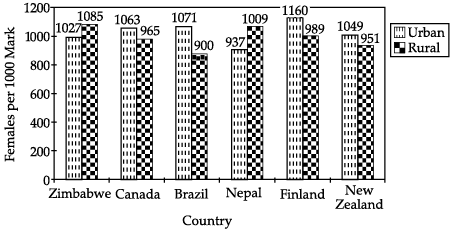 Which of these countries has a higher rural sex composition as compared to the urban one?
Which of these countries has a higher rural sex composition as compared to the urban one?- a)Brazil
- b)Finland
- c)Canada
- d)Nepal
Correct answer is option 'D'. Can you explain this answer?
Study the given graph carefully and answer the following questions:

Which of these countries has a higher rural sex composition as compared to the urban one?
a)
Brazil
b)
Finland
c)
Canada
d)
Nepal
|
|
Naina Sharma answered |
Nepal has a higher rural sex composition as compared to the urban one.
Study the given graph carefully and answer the following questions: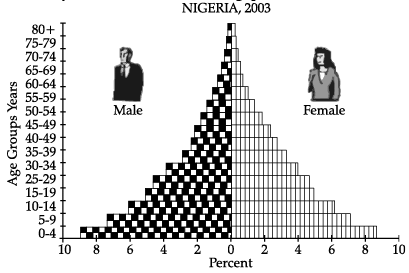 Which of these inferences can be drawn from the graph?
Which of these inferences can be drawn from the graph?- a)Low birth rate
- b)Low death rate
- c)Low growth rate
- d)High growth rate
Correct answer is option 'C'. Can you explain this answer?
Study the given graph carefully and answer the following questions:

Which of these inferences can be drawn from the graph?
a)
Low birth rate
b)
Low death rate
c)
Low growth rate
d)
High growth rate
|
|
Ojasvi Mehta answered |
Low growth rate can be inferred from the graph.
Study the given graph carefully and answer the following questions: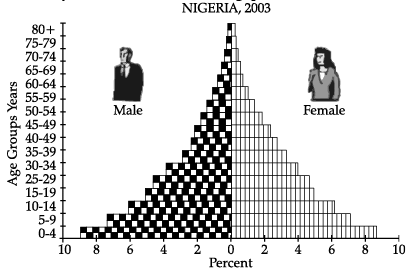 Which of these inferences can be drawn from the graph?
Which of these inferences can be drawn from the graph?- a)High birth rate
- b)Low growth rate
- c)High death rate
- d)High growth rate
Correct answer is option 'C'. Can you explain this answer?
Study the given graph carefully and answer the following questions:

Which of these inferences can be drawn from the graph?
a)
High birth rate
b)
Low growth rate
c)
High death rate
d)
High growth rate
|
|
Arun Yadav answered |
High death rate can be drawn from the graph.
Study the given graph carefully and answer the following questions: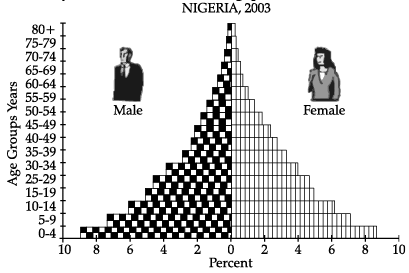 How is the population in different age groups distributed on the basis of gender?
How is the population in different age groups distributed on the basis of gender?- a)Males are more than females
- b)Females are more than males
- c)Males and females are almost evenly distributed
- d)No certain trend can be seen from the graph
Correct answer is option 'C'. Can you explain this answer?
Study the given graph carefully and answer the following questions:

How is the population in different age groups distributed on the basis of gender?
a)
Males are more than females
b)
Females are more than males
c)
Males and females are almost evenly distributed
d)
No certain trend can be seen from the graph
|
|
Arun Yadav answered |
Males and females are almost evenly distributed
Read the case study given below and answer the questions that follow:The working population (i.e., women and men of the age group – 15 to 59) take part in various occupations ranging from agriculture, forestry, fishing, manufacturing construction, commercial transport, services, communication and other unclassified services. Agriculture, forestry, fishing and mining are classified as primary activities manufacturing as secondary, transport, communication and other services as tertiary and the jobs related to research and developing ideas as quaternary activities. The proportion of working population engaged in these four sectors is a good indicator of the levels of economic development of a nation. This is because only a developed economy with industries and infrastructure can accommodate more workers in the secondary, tertiary and quaternary sector. If the economy is still in the primitive stages, then the proportion of people engaged in primary activities world be high as it involves extraction of natural resources.What is the age group which is considered as the working population?- a)14 to 49 years
- b)15 to 59 years
- c)16 to 69 years
- d)17 to 79 years
Correct answer is option 'B'. Can you explain this answer?
Read the case study given below and answer the questions that follow:
The working population (i.e., women and men of the age group – 15 to 59) take part in various occupations ranging from agriculture, forestry, fishing, manufacturing construction, commercial transport, services, communication and other unclassified services. Agriculture, forestry, fishing and mining are classified as primary activities manufacturing as secondary, transport, communication and other services as tertiary and the jobs related to research and developing ideas as quaternary activities. The proportion of working population engaged in these four sectors is a good indicator of the levels of economic development of a nation. This is because only a developed economy with industries and infrastructure can accommodate more workers in the secondary, tertiary and quaternary sector. If the economy is still in the primitive stages, then the proportion of people engaged in primary activities world be high as it involves extraction of natural resources.
What is the age group which is considered as the working population?
a)
14 to 49 years
b)
15 to 59 years
c)
16 to 69 years
d)
17 to 79 years
|
|
Arun Yadav answered |
The working age population is defined as those aged 15 to 59. This indicator measures the share of the working age population in total population.
Study the given graph carefully and answer the following questions: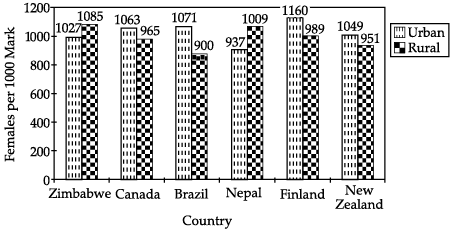 Which of these countries has rural sex composition above average?
Which of these countries has rural sex composition above average?- a)New Zealand
- b)Brazil
- c)Zimbabwe
- d)Canada
Correct answer is option 'C'. Can you explain this answer?
Study the given graph carefully and answer the following questions:

Which of these countries has rural sex composition above average?
a)
New Zealand
b)
Brazil
c)
Zimbabwe
d)
Canada
|
|
Ojasvi Mehta answered |
Zimbabwe has rural sex composition above average.
What is the sex ratio of countries like China, India, Saudi Arabia, Pakistan, Afghanistan?- a)Average
- b)Lower
- c)Higher
- d)None
Correct answer is option 'B'. Can you explain this answer?
What is the sex ratio of countries like China, India, Saudi Arabia, Pakistan, Afghanistan?
a)
Average
b)
Lower
c)
Higher
d)
None
|
|
Simran Rane answered |
B) Lower
China:
- The sex ratio in China is skewed towards males, with a higher number of males compared to females.
- This is primarily due to the cultural preference for male children, resulting in sex-selective practices such as female infanticide and sex-selective abortions.
- The one-child policy implemented in China from 1979 to 2015 also contributed to the imbalance, as many families preferred having a male child as their only offspring.
- The sex ratio at birth in China was reported to be around 114 males per 100 females in 2019.
India:
- Similar to China, India also has a lower sex ratio, favoring males.
- The preference for male children, known as son preference, is deeply rooted in Indian society.
- This preference leads to practices such as female infanticide, sex-selective abortions, and neglect of female children.
- The sex ratio at birth in India was reported to be around 110 males per 100 females in 2019.
Saudi Arabia:
- Saudi Arabia has a higher sex ratio, favoring females.
- This is primarily due to the large number of expatriate male workers in the country.
- Many men from different countries come to Saudi Arabia for employment, leading to a higher number of females compared to males among the Saudi population.
- The sex ratio in Saudi Arabia was reported to be around 105 males per 100 females in 2019.
Pakistan:
- Pakistan has a lower sex ratio, favoring males.
- Similar to China and India, Pakistan also has a cultural preference for male children, leading to practices such as female infanticide and sex-selective abortions.
- The sex ratio at birth in Pakistan was reported to be around 107 males per 100 females in 2019.
Afghanistan:
- Afghanistan has a lower sex ratio, favoring males.
- The preference for male children is prevalent in Afghan society, and this leads to practices such as female infanticide and sex-selective abortions.
- The ongoing conflict in Afghanistan also contributes to the lower sex ratio, as it disproportionately affects males.
- The sex ratio at birth in Afghanistan was reported to be around 106 males per 100 females in 2019.
In summary, countries like China, India, Saudi Arabia, Pakistan, and Afghanistan have lower sex ratios, indicating a higher number of males compared to females. This imbalance is primarily due to cultural preferences for male children and practices such as female infanticide and sex-selective abortions. However, it is important to note that sex ratios can vary over time and may be influenced by various factors such as government policies and social changes.
China:
- The sex ratio in China is skewed towards males, with a higher number of males compared to females.
- This is primarily due to the cultural preference for male children, resulting in sex-selective practices such as female infanticide and sex-selective abortions.
- The one-child policy implemented in China from 1979 to 2015 also contributed to the imbalance, as many families preferred having a male child as their only offspring.
- The sex ratio at birth in China was reported to be around 114 males per 100 females in 2019.
India:
- Similar to China, India also has a lower sex ratio, favoring males.
- The preference for male children, known as son preference, is deeply rooted in Indian society.
- This preference leads to practices such as female infanticide, sex-selective abortions, and neglect of female children.
- The sex ratio at birth in India was reported to be around 110 males per 100 females in 2019.
Saudi Arabia:
- Saudi Arabia has a higher sex ratio, favoring females.
- This is primarily due to the large number of expatriate male workers in the country.
- Many men from different countries come to Saudi Arabia for employment, leading to a higher number of females compared to males among the Saudi population.
- The sex ratio in Saudi Arabia was reported to be around 105 males per 100 females in 2019.
Pakistan:
- Pakistan has a lower sex ratio, favoring males.
- Similar to China and India, Pakistan also has a cultural preference for male children, leading to practices such as female infanticide and sex-selective abortions.
- The sex ratio at birth in Pakistan was reported to be around 107 males per 100 females in 2019.
Afghanistan:
- Afghanistan has a lower sex ratio, favoring males.
- The preference for male children is prevalent in Afghan society, and this leads to practices such as female infanticide and sex-selective abortions.
- The ongoing conflict in Afghanistan also contributes to the lower sex ratio, as it disproportionately affects males.
- The sex ratio at birth in Afghanistan was reported to be around 106 males per 100 females in 2019.
In summary, countries like China, India, Saudi Arabia, Pakistan, and Afghanistan have lower sex ratios, indicating a higher number of males compared to females. This imbalance is primarily due to cultural preferences for male children and practices such as female infanticide and sex-selective abortions. However, it is important to note that sex ratios can vary over time and may be influenced by various factors such as government policies and social changes.
The ageing population is a characteristic of- a)developing countries.
- b)developed countries.
- c)socialist countries.
- d)European countries.
Correct answer is option 'B'. Can you explain this answer?
The ageing population is a characteristic of
a)
developing countries.
b)
developed countries.
c)
socialist countries.
d)
European countries.
|
|
Nandita Joshi answered |
A greater proportion of population above 60 years represents an ageing population, which requires more expenditure on health care facilities. In most of the developed countries of the world, population in higher age groups has increased due to increased life expectancy. With a reduction in birth rates, the proportion of children in the population has declined.
What country in Europe has a higher sex ratio than china?- a)Russia
- b)Ukraine
- c)Moscow
- d)None
Correct answer is option 'A'. Can you explain this answer?
What country in Europe has a higher sex ratio than china?
a)
Russia
b)
Ukraine
c)
Moscow
d)
None
|
|
Mainak Goyal answered |
The correct answer is option 'A', Russia.
Explanation:
----------------
Higher Sex Ratio in Russia:
-----------------
Russia has a higher sex ratio than China. The sex ratio is the ratio of males to females in a population. In Russia, the sex ratio is approximately 0.86, meaning that there are 0.86 males for every female. This is higher than the sex ratio in China, which is approximately 0.94.
Reasons for Higher Sex Ratio in Russia:
-----------------
Several factors contribute to the higher sex ratio in Russia compared to China:
1. Historical Context:
- Russia has a history of wars and conflicts, including World War II, which resulted in a significant loss of male population.
- This historical context has contributed to a gender imbalance in Russia, with a higher number of females compared to males.
2. Life Expectancy:
- The life expectancy of males in Russia is lower than that of females.
- Factors such as alcoholism, smoking, and accidents contribute to a higher mortality rate among Russian men.
- This leads to a higher number of females in the population, resulting in a higher sex ratio.
3. Migration Patterns:
- Russia has experienced significant emigration of males to other countries, particularly for economic reasons.
- This further contributes to the gender imbalance and higher sex ratio in Russia.
Comparison with China:
-----------------
In comparison, China has a lower sex ratio than Russia. The sex ratio in China is influenced by the country's one-child policy, which was in effect from 1979 to 2015.
- The one-child policy led to a preference for male offspring, resulting in sex-selective abortions and a significant gender imbalance.
- The sex ratio in China is approximately 0.94, meaning that there are 0.94 males for every female.
Conclusion:
-----------------
In summary, Russia has a higher sex ratio than China. This difference can be attributed to various factors, including historical context, life expectancy, and migration patterns. The sex ratio in Russia is approximately 0.86, while in China, it is approximately 0.94.
Explanation:
----------------
Higher Sex Ratio in Russia:
-----------------
Russia has a higher sex ratio than China. The sex ratio is the ratio of males to females in a population. In Russia, the sex ratio is approximately 0.86, meaning that there are 0.86 males for every female. This is higher than the sex ratio in China, which is approximately 0.94.
Reasons for Higher Sex Ratio in Russia:
-----------------
Several factors contribute to the higher sex ratio in Russia compared to China:
1. Historical Context:
- Russia has a history of wars and conflicts, including World War II, which resulted in a significant loss of male population.
- This historical context has contributed to a gender imbalance in Russia, with a higher number of females compared to males.
2. Life Expectancy:
- The life expectancy of males in Russia is lower than that of females.
- Factors such as alcoholism, smoking, and accidents contribute to a higher mortality rate among Russian men.
- This leads to a higher number of females in the population, resulting in a higher sex ratio.
3. Migration Patterns:
- Russia has experienced significant emigration of males to other countries, particularly for economic reasons.
- This further contributes to the gender imbalance and higher sex ratio in Russia.
Comparison with China:
-----------------
In comparison, China has a lower sex ratio than Russia. The sex ratio in China is influenced by the country's one-child policy, which was in effect from 1979 to 2015.
- The one-child policy led to a preference for male offspring, resulting in sex-selective abortions and a significant gender imbalance.
- The sex ratio in China is approximately 0.94, meaning that there are 0.94 males for every female.
Conclusion:
-----------------
In summary, Russia has a higher sex ratio than China. This difference can be attributed to various factors, including historical context, life expectancy, and migration patterns. The sex ratio in Russia is approximately 0.86, while in China, it is approximately 0.94.
Read the case study given below and answer the questions that follow:The working population (i.e., women and men of the age group – 15 to 59) take part in various occupations ranging from agriculture, forestry, fishing, manufacturing construction, commercial transport, services, communication and other unclassified services. Agriculture, forestry, fishing and mining are classified as primary activities manufacturing as secondary, transport, communication and other services as tertiary and the jobs related to research and developing ideas as quaternary activities. The proportion of working population engaged in these four sectors is a good indicator of the levels of economic development of a nation. This is because only a developed economy with industries and infrastructure can accommodate more workers in the secondary, tertiary and quaternary sector. If the economy is still in the primitive stages, then the proportion of people engaged in primary activities world be high as it involves extraction of natural resources.If the economy is still in the primitive stages, then the proportion of people engaged in primary activities world be:- a)Lesser
- b)Higher
- c)Moderate
- d)Negligible
Correct answer is option 'B'. Can you explain this answer?
Read the case study given below and answer the questions that follow:
The working population (i.e., women and men of the age group – 15 to 59) take part in various occupations ranging from agriculture, forestry, fishing, manufacturing construction, commercial transport, services, communication and other unclassified services. Agriculture, forestry, fishing and mining are classified as primary activities manufacturing as secondary, transport, communication and other services as tertiary and the jobs related to research and developing ideas as quaternary activities. The proportion of working population engaged in these four sectors is a good indicator of the levels of economic development of a nation. This is because only a developed economy with industries and infrastructure can accommodate more workers in the secondary, tertiary and quaternary sector. If the economy is still in the primitive stages, then the proportion of people engaged in primary activities world be high as it involves extraction of natural resources.
If the economy is still in the primitive stages, then the proportion of people engaged in primary activities world be:
a)
Lesser
b)
Higher
c)
Moderate
d)
Negligible
|
|
Rajesh Gupta answered |
If the economy is still in the primitive stages, then the proportion of people engaged in primary activities world be higher.
Study the given graph carefully and answer the following questions: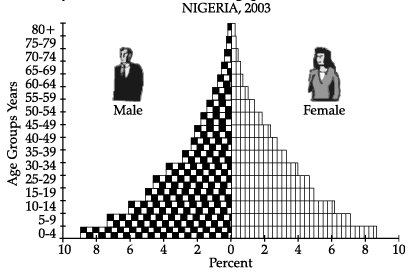 Which age group constitutes the maximum population size in Nigeria?
Which age group constitutes the maximum population size in Nigeria?- a)Lower age group
- b)Middle age group
- c)Higher age group
- d)Randomly distributed
Correct answer is option 'A'. Can you explain this answer?
Study the given graph carefully and answer the following questions:

Which age group constitutes the maximum population size in Nigeria?
a)
Lower age group
b)
Middle age group
c)
Higher age group
d)
Randomly distributed
|
|
Hansa Sharma answered |
Lower age group constitutes the maximum population size in Nigeria.
Study the given graph carefully and answer the following questions: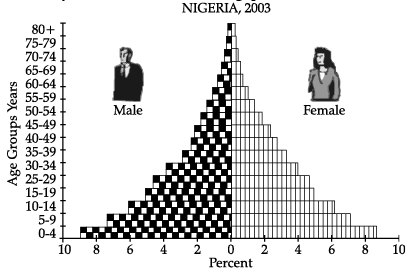 What type of gender preference can be observed in the country?
What type of gender preference can be observed in the country?- a)Males are more preferred than females
- b)Females are more preferred than males
- c)It cannot be inferred from the graph
- d)None of these
Correct answer is option 'D'. Can you explain this answer?
Study the given graph carefully and answer the following questions:

What type of gender preference can be observed in the country?
a)
Males are more preferred than females
b)
Females are more preferred than males
c)
It cannot be inferred from the graph
d)
None of these
|
|
Ojasvi Mehta answered |
Males and females are both equally preferred.
Read the case study given below and answer the questions that follow:“Population ageing is the process by which the share of the older population becomes proportionally larger. This is a new phenomenon of the 20th century.In most of the developed countries of the world, the population in higher age groups has increased due to increased life expectancy. With a reduction in birth rates, the proportion of children in the population has declined.”What values are required to take care of the ageing population?- a)Nursing spirit
- b)Government policies
- c)Foreign policies
- d)Speeding birth rates
Correct answer is option 'A'. Can you explain this answer?
Read the case study given below and answer the questions that follow:
“Population ageing is the process by which the share of the older population becomes proportionally larger. This is a new phenomenon of the 20th century.
In most of the developed countries of the world, the population in higher age groups has increased due to increased life expectancy. With a reduction in birth rates, the proportion of children in the population has declined.”
What values are required to take care of the ageing population?
a)
Nursing spirit
b)
Government policies
c)
Foreign policies
d)
Speeding birth rates
|
|
Hansa Sharma answered |
Nursing spirit is required to take care of the ageing population.
Study the given graph carefully and answer the following questions: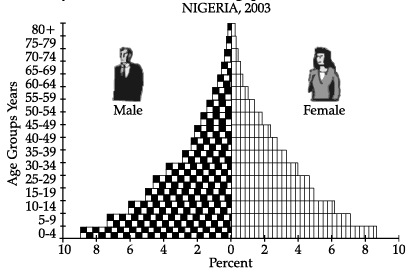 Which age group constitutes the minimum population size in Nigeria?
Which age group constitutes the minimum population size in Nigeria?- a)Lower age group
- b)Middle age group
- c)Higher age group
- d)Randomly distributed
Correct answer is option 'C'. Can you explain this answer?
Study the given graph carefully and answer the following questions:

Which age group constitutes the minimum population size in Nigeria?
a)
Lower age group
b)
Middle age group
c)
Higher age group
d)
Randomly distributed
|
|
Naina Sharma answered |
Higher age group constitutes the minimum population size in Nigeria.
The division of the population into rural and urban is based on what?- a)Residence
- b)House
- c)Apartment
- d)None
Correct answer is option 'A'. Can you explain this answer?
The division of the population into rural and urban is based on what?
a)
Residence
b)
House
c)
Apartment
d)
None
|
|
Nilesh Chakraborty answered |
**Explanation:**
The division of the population into rural and urban is primarily based on **residence**. This categorization is used to differentiate and classify the population based on their living environment and location.
**1. Rural Areas:**
Rural areas are characterized by less population density, agricultural activities, and natural landscapes. These areas are typically located outside of cities and towns and are characterized by open spaces, fields, farms, and villages. The majority of the population in rural areas is engaged in agriculture, farming, and other traditional occupations. The infrastructure in rural areas is often less developed compared to urban areas, with limited access to amenities and services.
**2. Urban Areas:**
Urban areas, on the other hand, are characterized by higher population density, industrialization, and urban infrastructure. These areas encompass cities, towns, and densely populated regions. Urban areas are centers of economic, social, and cultural activities, with a concentration of industries, businesses, educational institutions, healthcare facilities, and other services. Urban dwellers are often engaged in non-agricultural professions, such as manufacturing, commerce, services, and technology.
**Reasons for the Division:**
The division of the population into rural and urban is based on several factors, including:
1. **Economic Activities:** Rural areas are primarily engaged in agriculture and farming, while urban areas are centers of industrial, commercial, and service-oriented economic activities.
2. **Infrastructure:** Urban areas have better-developed infrastructure, including transportation networks, communication facilities, healthcare systems, educational institutions, and housing complexes. Rural areas often lack these facilities or have limited access to them.
3. **Population Density:** Urban areas have higher population density compared to rural areas due to the concentration of people in cities and towns.
4. **Amenities and Services:** Urban areas offer a wider range of amenities and services, such as shopping centers, entertainment venues, public transportation, and specialized healthcare facilities.
5. **Social and Cultural Differences:** Rural and urban areas often have distinct social and cultural characteristics. Rural areas tend to have a close-knit community and traditional values, while urban areas are more diverse and cosmopolitan.
6. **Environmental Factors:** Rural areas are often characterized by natural landscapes, farmland, and open spaces, while urban areas have a more built-up environment with skyscrapers, roads, and concrete structures.
In conclusion, the division of the population into rural and urban is primarily determined by their place of residence. This categorization helps in understanding the differences in economic activities, infrastructure, population density, amenities, and social dynamics between rural and urban areas.
The division of the population into rural and urban is primarily based on **residence**. This categorization is used to differentiate and classify the population based on their living environment and location.
**1. Rural Areas:**
Rural areas are characterized by less population density, agricultural activities, and natural landscapes. These areas are typically located outside of cities and towns and are characterized by open spaces, fields, farms, and villages. The majority of the population in rural areas is engaged in agriculture, farming, and other traditional occupations. The infrastructure in rural areas is often less developed compared to urban areas, with limited access to amenities and services.
**2. Urban Areas:**
Urban areas, on the other hand, are characterized by higher population density, industrialization, and urban infrastructure. These areas encompass cities, towns, and densely populated regions. Urban areas are centers of economic, social, and cultural activities, with a concentration of industries, businesses, educational institutions, healthcare facilities, and other services. Urban dwellers are often engaged in non-agricultural professions, such as manufacturing, commerce, services, and technology.
**Reasons for the Division:**
The division of the population into rural and urban is based on several factors, including:
1. **Economic Activities:** Rural areas are primarily engaged in agriculture and farming, while urban areas are centers of industrial, commercial, and service-oriented economic activities.
2. **Infrastructure:** Urban areas have better-developed infrastructure, including transportation networks, communication facilities, healthcare systems, educational institutions, and housing complexes. Rural areas often lack these facilities or have limited access to them.
3. **Population Density:** Urban areas have higher population density compared to rural areas due to the concentration of people in cities and towns.
4. **Amenities and Services:** Urban areas offer a wider range of amenities and services, such as shopping centers, entertainment venues, public transportation, and specialized healthcare facilities.
5. **Social and Cultural Differences:** Rural and urban areas often have distinct social and cultural characteristics. Rural areas tend to have a close-knit community and traditional values, while urban areas are more diverse and cosmopolitan.
6. **Environmental Factors:** Rural areas are often characterized by natural landscapes, farmland, and open spaces, while urban areas have a more built-up environment with skyscrapers, roads, and concrete structures.
In conclusion, the division of the population into rural and urban is primarily determined by their place of residence. This categorization helps in understanding the differences in economic activities, infrastructure, population density, amenities, and social dynamics between rural and urban areas.
Which of the following countries rank high on human development?- a)Mexico
- b)India
- c)Nigeria
- d)U.S.A
Correct answer is option 'D'. Can you explain this answer?
Which of the following countries rank high on human development?
a)
Mexico
b)
India
c)
Nigeria
d)
U.S.A

|
Kritarth Melkani answered |
Human development is a well-being concept within a field of international development. It involves studies of the human condition with its core being the capability approach. The inequality adjusted Human Development Index is used as a way of measuring actual progress in human development by the United Nations.
Read the case study given below and answer the questions that follow:The division of population into rural and urban is based on the residence. This division is necessary because rural and urban life styles differ from each other in terms of their livelihood and social conditions. The age-sex-occupational structure, density of population and level of development vary between rural and urban areas.The criteria for differentiating rural and urban population varies from country to country. In general terms rural areas are those where people are engaged in primary activities and urban areas are those when majority of the working population is engaged in non- primary activities.The criteria for differentiating rural and urban population varies from:- a)country to country
- b)state to state
- c)city to city
- d)district to district
Correct answer is option 'A'. Can you explain this answer?
Read the case study given below and answer the questions that follow:
The division of population into rural and urban is based on the residence. This division is necessary because rural and urban life styles differ from each other in terms of their livelihood and social conditions. The age-sex-occupational structure, density of population and level of development vary between rural and urban areas.
The criteria for differentiating rural and urban population varies from country to country. In general terms rural areas are those where people are engaged in primary activities and urban areas are those when majority of the working population is engaged in non- primary activities.
The criteria for differentiating rural and urban population varies from:
a)
country to country
b)
state to state
c)
city to city
d)
district to district
|
|
Arun Yadav answered |
The criteria for differentiating rural and urban population varies from country to country. In general terms rural areas are those where people are engaged in primary activities and urban areas are those when majority of the working population is engaged in non-primary activities
Read the case study given below and answer the questions that follow:“Population ageing is the process by which the share of the older population becomes proportionally larger. This is a new phenomenon of the 20th century.In most of the developed countries of the world, the population in higher age groups has increased due to increased life expectancy. With a reduction in birth rates, the proportion of children in the population has declined.”What leads to population ageing?- a)Increased life expectancy
- b)Decreased life expectancy
- c)Slow Immigration
- d)None of the Above
Correct answer is option 'A'. Can you explain this answer?
Read the case study given below and answer the questions that follow:
“Population ageing is the process by which the share of the older population becomes proportionally larger. This is a new phenomenon of the 20th century.
In most of the developed countries of the world, the population in higher age groups has increased due to increased life expectancy. With a reduction in birth rates, the proportion of children in the population has declined.”
What leads to population ageing?
a)
Increased life expectancy
b)
Decreased life expectancy
c)
Slow Immigration
d)
None of the Above
|
|
Ojasvi Mehta answered |
The ageing of the world's populations is the result of the continued decline in fertility rates and increased life expectancy. This demographic change has resulted in increasing numbers and proportions of people who are over 60. ... creation of age-friendly environments.
Agriculture, fishing, forestry, mining, etc. are classified as:- a)Primary Occupations
- b)Secondary Occupations
- c)Tertiary Occupations
- d)Quaternary Occupations
Correct answer is option 'A'. Can you explain this answer?
Agriculture, fishing, forestry, mining, etc. are classified as:
a)
Primary Occupations
b)
Secondary Occupations
c)
Tertiary Occupations
d)
Quaternary Occupations
|
|
Kunal Verma answered |
Primary occupations are those occupations, which involve using raw materials from the environment.
How many males per 100 females does the world population have?- a)106
- b)98
- c)102
- d)110
Correct answer is option 'C'. Can you explain this answer?
How many males per 100 females does the world population have?
a)
106
b)
98
c)
102
d)
110
|
|
Harsh Chawla answered |
**Explanation:**
To calculate the number of males per 100 females in the world population, we need to consider the sex ratio. The sex ratio is defined as the number of males per 100 females.
According to the United Nations, the estimated sex ratio for the world population is approximately 102 males per 100 females. This means that for every 100 females, there are 102 males.
**Factors influencing the sex ratio:**
Several factors can influence the sex ratio of a population, including biological and social factors. Some of these factors include:
1. Biological factors: The sex ratio may be influenced by biological factors such as the probability of conceiving a male or female child. In general, there is a slightly higher probability of conceiving a male child, which can contribute to a slightly higher sex ratio.
2. Migration: Migration patterns can also influence the sex ratio of a population. For example, if there is a higher number of male migrants compared to female migrants, it can result in a higher sex ratio in the destination country.
3. Cultural and social factors: Cultural and social factors can also play a role in shaping the sex ratio. In some societies, there may be a preference for having male children, leading to imbalanced sex ratios.
4. War and conflict: In regions affected by war and conflict, the sex ratio can be significantly altered. For example, if a large number of young males are killed in a conflict, it can result in a lower sex ratio in the affected population.
**Conclusion:**
In conclusion, the estimated number of males per 100 females in the world population is approximately 102. This sex ratio is influenced by various factors such as biological, social, and cultural factors. It is important to note that the sex ratio can vary among different countries and regions.
To calculate the number of males per 100 females in the world population, we need to consider the sex ratio. The sex ratio is defined as the number of males per 100 females.
According to the United Nations, the estimated sex ratio for the world population is approximately 102 males per 100 females. This means that for every 100 females, there are 102 males.
**Factors influencing the sex ratio:**
Several factors can influence the sex ratio of a population, including biological and social factors. Some of these factors include:
1. Biological factors: The sex ratio may be influenced by biological factors such as the probability of conceiving a male or female child. In general, there is a slightly higher probability of conceiving a male child, which can contribute to a slightly higher sex ratio.
2. Migration: Migration patterns can also influence the sex ratio of a population. For example, if there is a higher number of male migrants compared to female migrants, it can result in a higher sex ratio in the destination country.
3. Cultural and social factors: Cultural and social factors can also play a role in shaping the sex ratio. In some societies, there may be a preference for having male children, leading to imbalanced sex ratios.
4. War and conflict: In regions affected by war and conflict, the sex ratio can be significantly altered. For example, if a large number of young males are killed in a conflict, it can result in a lower sex ratio in the affected population.
**Conclusion:**
In conclusion, the estimated number of males per 100 females in the world population is approximately 102. This sex ratio is influenced by various factors such as biological, social, and cultural factors. It is important to note that the sex ratio can vary among different countries and regions.
Chapter doubts & questions for Population Composition - Geography CUET UG Mock Test Series 2026 2025 is part of Humanities/Arts exam preparation. The chapters have been prepared according to the Humanities/Arts exam syllabus. The Chapter doubts & questions, notes, tests & MCQs are made for Humanities/Arts 2025 Exam. Find important definitions, questions, notes, meanings, examples, exercises, MCQs and online tests here.
Chapter doubts & questions of Population Composition - Geography CUET UG Mock Test Series 2026 in English & Hindi are available as part of Humanities/Arts exam.
Download more important topics, notes, lectures and mock test series for Humanities/Arts Exam by signing up for free.
Geography CUET UG Mock Test Series 2026
3 docs|62 tests
|

Contact Support
Our team is online on weekdays between 10 AM - 7 PM
Typical reply within 3 hours
|
Free Exam Preparation
at your Fingertips!
Access Free Study Material - Test Series, Structured Courses, Free Videos & Study Notes and Prepare for Your Exam With Ease

 Join the 10M+ students on EduRev
Join the 10M+ students on EduRev
|

|
Create your account for free
OR
Forgot Password
OR
Signup to see your scores
go up within 7 days!
Access 1000+ FREE Docs, Videos and Tests
Takes less than 10 seconds to signup
